Chapter 8 The Human Body Introduction
The human body refers to the entire structure of a human being and comprises a head, neck, trunk (which includes the thorax and abdomen), forelimbs (arms and hands), and hind limbs (legs and feet).
Every part of the body is composed of various types of cells.
The human body is a complex, highly organized structure made up of unique cells that work together to accomplish the specific functions necessary for sustaining life.
Many people have compared the human body to a machine. Think about some common machines, such as drills and washing machines.
Each machine consists of many parts, and each part does a specific job, yet all the parts work together to perform an overall function.
Read And Learn More: WBBSE Notes For Class 6 School Science
The human body is like a machine in all these ways. In fact, it may be the most fantastic machine on earth.
Human beings are arguably the most complex organisms on this planet.
Imagine billions of microscopic parts, each with its own identity, working together in an organized manner for the benefit of the total being.
The human body is a single structure but it is made up of billions of smaller structures of four major kinds.
1. Cells:
Cells have long been recognized as the simplest units of living matter that can maintain life and reproduce themselves.
The human body, which is made up of numerous cells, begins as a single, newly fertilized cell.
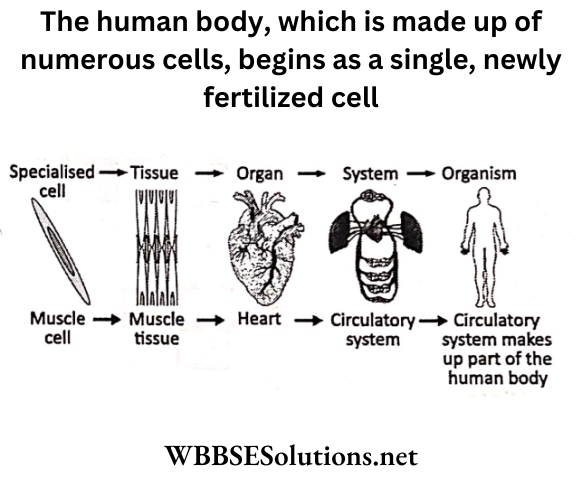
2. Tissues:
Tissues are somewhat more complex units than cells. By definition, a tissue is an organization of a great many similar cells with varying amounts and kinds of non-living, intercellular substance between them.
3. Organs:
Organs are more complex units. than tissues. An organ is an organization of several different kinds of tissues so arranged that together they can perform a special function.
For example, the stomach is an organization of muscles, connective, epithelial, and nervous. tissues.
4. System:
Systems are the most complex of the component units of the human body. A system is an organization of varying numbers and kinds of organs so arranged that together they can perform complex functions for the body.
Chapter 8 The Human Body Systems of the Human Body
Our body consists of a number of biological systems that carry out specific functions necessary for everyday living.
The job of the circulatory system is to move blood, nutrients, oxygen, carbon dioxide, and hormones, around the body.
It consists of the heart, blood, and blood vessels (arteries, veins, and capillaries).
The digestive system consists of a series of connected organs that together allow the body to break down and absorb food, and remove waste (unabsorbed food residues).
It includes the mouth, esophagus, stomach, small and large intestine, rectum, and anus. The liver and pancreas also play a role in the digestive system because they produce digestive juices.
The endocrine system consists of eight major glands that secrete several hormones into the blood.
These hormones, in turn, travel to different tissues and regulate various bodily functions, such as metabolism, growth, and sexual function.
The immune system is the body’s defense against bacteria, viruses, and other pathogens that may be harmful.
It includes lymph nodes, spleen, bone marrow, the thymus, and leukocytes, which are white blood cells such as lymphocytes (including B-cells and T-cells).
The lymphatic system includes lymph nodes, lymph ducts, and lymph vessels, and also plays a role in the body’s defense.
Its main job is to make and move lymph, a clear fluid that contains white blood cells, which helps the body to fight infections.
The lymphatic system also removes excess lymph fluid from body tissues and returns it to the blood.
The nervous system controls both voluntary action (like conscious movement) and involuntary action (like breathing) and sends signals to different parts of the body.
The central nervous system includes the brain and spinal cord. The peripheral nervous system consists of nerves that connect every other part of the body to the central nervous system.
muscle and cardiac muscle) that aid in movement, blood flow, and other bodily functions. Skeletal muscle is connected to bone and helps in voluntary movement.
There are about 650 skeletal muscles. Smooth muscle is found inside organs and helps to move substances through organs.
Cardiac muscle is found in the heart and helps to pump blood. The reproductive system allows humans to reproduce. The male reproductive system includes the penis and a pair of testes that produce sperm.
The female reproductive system consists of the vagina, the uterus, and a pair of ovaries that produce eggs.
During conception, a sperm cell fuses with an egg cell, which creates a fertilized egg that implants and grows in the uterus.
Our body is supported by the skeletal system, which consists of 206 bones, connected by ligaments.
The skeleton not only helps us to move but also is involved in the production of blood cells and the storage of calcium.
The respiratory system allows us to take in vital oxygen and expel carbon dioxide in a process called breathing. It consists mainly of the trachea with its branches and a pair of lungs.
The urinary system helps to eliminate the water-soluble waste products from the body (separated from blood), in the form of urine.
The chief waste product called urea is produced when a certain food is broken down. The whole system includes two kidneys, two ureters, the bladder, two sphincter muscles, and the urethra.
Urine produced by the kidneys travels down the ureters to the bladder and finally exits the body through the urethra.
The skin or integumentary system, is the body’s largest organ. It protects us from the outside world and is our first defense against bacteria, viruses, and other pathogens.
Our skin also helps to regulate body temperature and eliminate waste through perspiration. In addition to skin, the integumentary system includes hair and nails.
Chapter 8 The Human Body Vital Organs Of The Human Body
Humans have several vital organs for survival. Some of these are The brain is the body’s control center, o receiving and sending signals from and to other organs through the nerves and also through corn-secreted hormones.
It is responsible for our thoughts, feelings, memory storage, and general perception of the world.
The heart is responsible for pumping blood throughout our body.
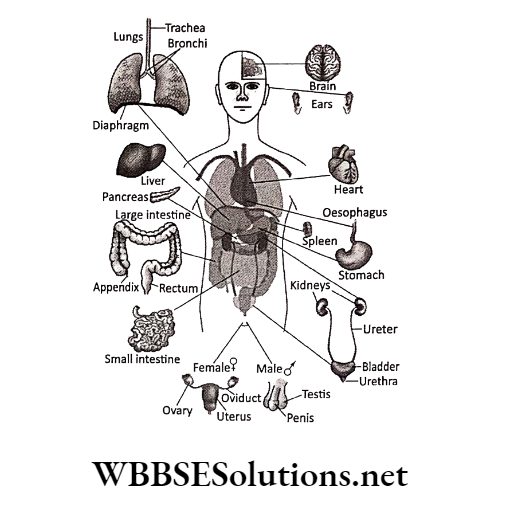
The job of the kidneys is to remove waste and extra fluid from the blood. The kidneys eliminate urea and other waste products in the form of urine.
The liver has many functions including detoxifying harmful chemicals, breakdown of drugs, secretion of bile, and production of blood-clotting proteins.
The lungs are responsible for removing oxygen from the air we breathe in and transferring it to our blood so that it can be sent to our cells.
The lungs also remove carbon dioxide produced in the body which we exhale. albo bould
Chapter 8 The Human Body Heart
We see and hear about the heart everywhere. A long time ago, people even thought that their emotions came from their hearts, maybe because the heart beats faster when a person is scared or excited.
Now we know that emotions come from the brain and in this case, the brain directs the heart to speed up. So what’s the heart up to then? How does it function? What does it look like? Let’s find out.
The human heart is a small organ, shaped somewhat like an upside-down pear. But actually, the heart is a muscle.
The weight of the heart can be anything in between 200-400 grams. It is about a fist in size. The heart sends blood around the whole body.
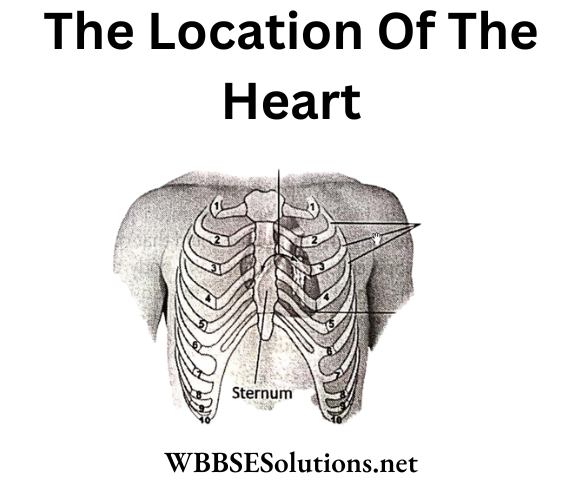
Definition:
The heart is hollow muscular organ brains that pump blood through the circulatory system in a rhythmic contraction and dilation.
Location of the human heart: In simplest terms, if you wish to know the exact location of the human heart, note that it is placed in the upper part of the body, on the left side of the chest.
The chest is just behind the sternum (the long flat bone at the front of the rib cage) and in front of the vertebral column.
In short, it is located anterior to the vertebral column in the back and posterior to the sternum in the chest.
If you look at the anatomy of the human heart and the human body, you will find that the heart is located in between the two lungs.
In 99% of the cases, the heart is located on the left side of the chest. However, in rare cases, the heart can also be found on the right side of the chest. This condition is known as dextrocardia.
Structure of the human heart:
The heart is the hollow, muscular organ in the thoracic cavity (chest) that maintains the circulation of blood throughout the body. It is surrounded by a membrane called the pericardium.
The pericardial cavity-the potential space between the pericardium and the heart-contains the watery pericardial fluid. This fluid prevents friction between the pericardium and the heart.
The heart wall consists of the epicardium (outer layer), the myocardium (middle layer comprised of cardiac muscle tissue), and the endocardium (lining of the myocardium that covers the heart valves).
The heart of a normal adult human beats at the rate of about 72 per minute. How does the heartbeat? Before each beat, the heart gets filled with blood.
Then its muscle contracts to squirt the blood along. When the heart contracts, it squeezes-try squeezing your hand into a fist. That’s what your heart does so that it can squirt out the blood.
Your heart does this all day and all night, all the time. The heart is a hard worker.
The heart is made up of four different blood-filled areas and each of these areas is called a chamber. There are two chambers on each side of the heart.
One chamber is at the top and one chamber is at the bottom. The two chambers on top are called the atria. If you are talking only about one, call it an atrium.
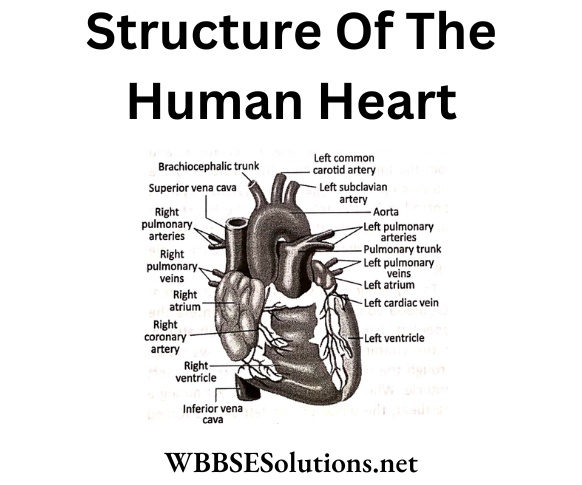
The atria are the chambers that are filled with the blood returning to the heart from the body and lungs. The heart’s right atrium.
The two chambers at the bottom are called the ventricles. The heart has a left ventricle and a right ventricle. Their job is to squirt out the blood to the body and lungs.
Running down the middle of the heart is a thick wall of muscle called the septum. The septum’s job is to separate the left side and the right side of the heart.
The atria and ventricles work as a team-the atria get filled with blood, then dump it into the ventricles. The ventricles then squeeze, pumping blood out of the heart.
While the ventricles are squeezing, the atria are refilled and get ready for the next contraction.
Blood flow relies on four special valves inside the heart. A valve lets something in and keeps it there by closing-think of walking through a door. The door shuts behind you and keeps you from going backward.
Two of the heart valves are the mitral or bicuspid valve and the tricuspid valve. They let blood flow from the atria to the ventricles.
The other two are called the aortic valve and pulmonary valve and they are in charge of controlling the flow as the blood leaves the heart.
These valves all work to keep the blood flowing forward. They open up to let the blood move ahead, then they close quickly to keep the blood from flowing backward.
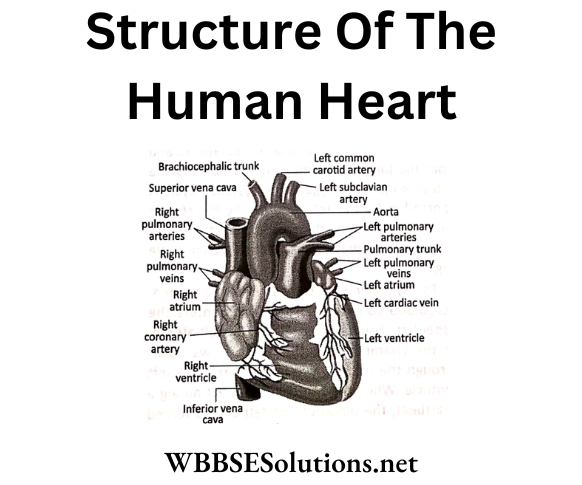
You probably guessed that the blood just doesn’t slosh around your body once it leaves the heart. It moves through many tubes called arteries and veins, which together are called blood vessels.
These blood vessels are attached to the heart. The blood vessels that carry blood away from the heart are called arteries. The ones that carry blood back to the heart are called veins.
The movement of the blood through the heart and around the body is called circulation and your heart is really good at it. It takes less than 60 seconds to pump blood to every cell in your body.
Your body needs this steady supply of blood to keep it working right. Blood delivers oxygen to all the body’s cells. To stay alive, a person needs healthy, living cells.
Without oxygen, these cells would die. If that oxygen-rich blood doesn’t circulate as it should, a person could die.
The left side of the heart sends that oxygen-rich blood out to the body. The body takes the oxygen out of the blood and uses it in the body’s cells.
When the cells use oxygen, they make carbon dioxide and other stuff that is carried away by the blood. It is like the blood delivers lunch to the cells and then has to pick up the trash.
The returning blood enters the right side of the heart. The right ventricle pumps the blood to the lungs for a little freshening up.
In the lungs, carbon dioxide is removed from the blood and sent out of the body when we exhale.
An inhale, in the form of a fresh breath of oxygen, enters the blood to start the process again. And remember, it all happens in about a minute.
When we go for a checkup, our doctor uses a stethoscope to listen carefully to our hearts. A healthy heart makes a lub-dub sound with each beat.
This sound comes from the valves shutting on the blood inside the heart. The first sound (the lub) happens when the mitral and tricuspid valves close.
The next sound (the dub) happens when the aortic and pulmonary valves close after the blood has been squeezed out of the heart.
Even though your heart is inside you, there is an easy way to know it is working from the outside. It is your pulse.
You can find your pulse by lightly pressing on the skin anywhere there is a
Running just beneath your skin. Two good places to find it are on the side of your neck and the inside of your wrist, just below the thumb.
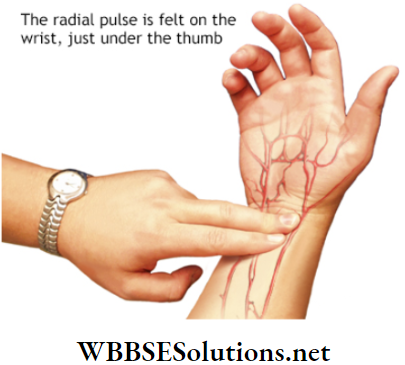
You will know that you have found your pulse when you can feel a small beat under your skin. Each beat is caused by the contraction (squeezing) of your heart.
If you want to find out what your heart rate is, use a watch with a second hand and count how many beats you feel in 1 minute. When you are resting, you will probably feel between 70 and 80 beats per minute.
When you run around a lot, your body needs a lot more oxygen-filled blood. Your heart pumps faster to supply the oxygen-filled blood that your body needs.
You may even feel your heart pounding in your chest. Try running in a place or jumping rope for a few minutes and taking your pulse again-now how many beats do you count in 1 minute?
The circulation of blood:
The human circulatory system is really a two-part system whose purpose is to bring oxygen-bearing blood to all the tissues of the body.
When the heart contracts it pushes the blood out into two major loops or cycles.
In the systemic loop, the blood circulates into the body’s systems, bringing oxygen to all its organs, structures, and tissues and collecting carbon dioxide waste.
In the Pulmonary loop, the blood circulates to and from the lungs, to release the carbon dioxide and pick up new oxygen.
The systemic cycle is controlled by the left side of the heart, and the pulmonary cycle by the right side of the heart. Let’s look at what happens during each cycle.
The systemic loop begins when the oxygen-rich blood coming from the lungs enters the upper left chamber of the heart, the left atrium.
As the chamber fills, the blood flows down through the mitral valve into the relaxing left ventricle. When the ventricles contract during a heartbeat, the blood on the left side is forced into the aorta.
This largest artery of the body is an inch wide. The blood leaving the aorta brings oxygen to all the body’s cells through the network of ever-smaller arteries and capillaries.
The used blood from the body returns to the heart through the network of veins. All of the blood from the body is eventually collected into the two largest veins the superior vena cava.
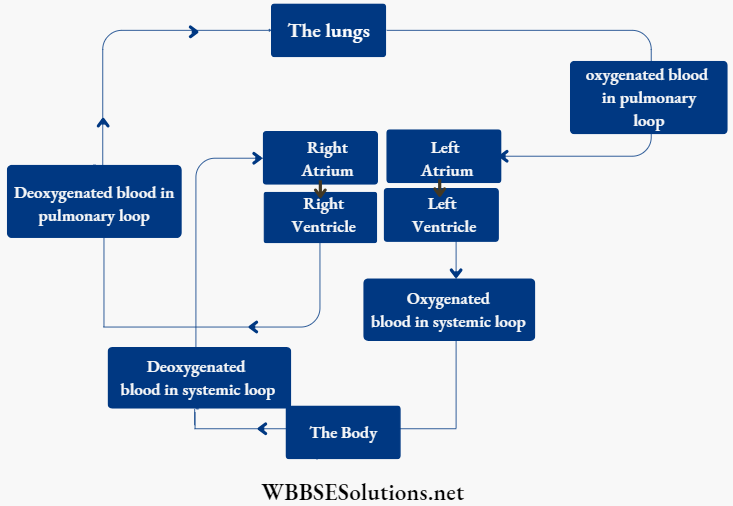
Which receives blood from the upper body, and the inferior vena cava, which receives blood from the lower body region. Both venae cavae empty the blood into the right atrium of the heart.
From here the blood begins its journey through the pulmonary cycle. From the right atrium, the blood descends into the right ventricle through the tricuspid valve.
When the ventricles contract, the blood in the right ventricle is pushed into the pulmonary artery that branches into two main parts one going to the left lung, and one to the right lung.
The fresh, oxygen-rich blood returns to the left atrium of the heart through the pulmonary veins.
Although the circulatory system is made up of two cycles, both happen at the same time. The contraction of the heart muscle starts in the two atria, which push the blood into the ventricles.
Then the walls of the ventricles squeeze together and force the blood out into the arteries: the aorta to the body and the pulmonary artery to the lungs.
Afterward, the heart muscle relaxes, allowing blood to flow in from the veins and fill the atria again.
In healthy people, the normal (resting) heart rate is about 72 beats per minute, but it can go much higher during strenuous exercise.
Scientists have estimated that it takes about 30 seconds for a given portion of the blood to complete the
Entire cycle:
from lungs to heart to body, back to the heart, and out to the lungs.
Conduction system:
An electrical impulse travels through the heart and initiates contractions in the chambers.
The heart’s “spark plug” is an area of specialized heart tissue called the sino- atrial node (SA node), which is located in the right atrium.
Each time the SA node “fires”, an electrical impulse is generated, that travels through the right and left atria, signaling these chambers to contract and pump blood into the ventricles.
Isidore to The impulse then travels into another area of specialized heart tissue called the atrioventricular node (AV node), which is located between the atria and the ventricles.
The 2 electrical impulses are conducted through the AVA node and wire-like pathways (Bundle of His and d Purkinje fibers) to the ventricles, signaling the ventricles to contract and pump blood into the lungs and throughout the body.
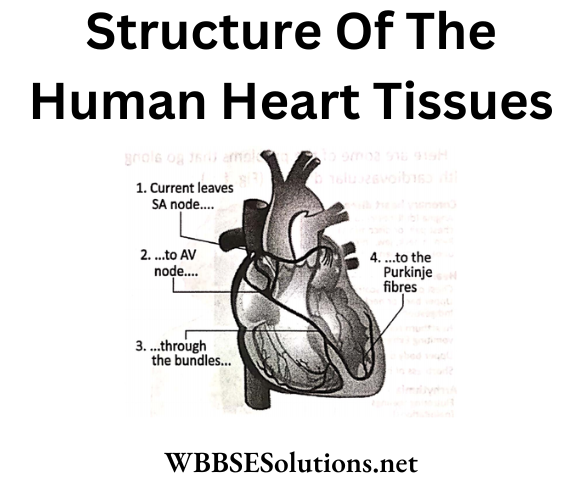
As the SA node maintains the pace of the heartbeat, it is also known as a natural pacemaker. If it does not function, an artificial pacemaker has to be implanted.
The normal sequence of electrical activation of the chambers of the heart is called sinus rhythm. It occurs each time the heart beats, usually about 60 to 80 times every minute.
In a normal heartbeat, the atria contract simultaneously while the ventricles relax. Then, the ventricles relax, and the atria contract.
The term systole refers to contraction and the term diastole refers to relaxation. A heartbeat consists of the systole and diastole of the atria and the systole and diastole of the ventricles.
Problems of the Heart:
You know how important your heart is, so it is no wonder people worry when they hear someone has heart problems. Heart disease, also called.
Cardiovascular disease:
Mainly affects older. people and means that there are problems with the heart and blood vessels.
You might know someone who has cardiovascular disease because several people in our society have some form of it.
This disease includes a variety of problems, including high blood pressure, hardening of the arteries, chest pain, heart attacks, and strokes.
Milanese te The heart is the center of the cardiovascular system. Through the body’s blood vessels, the d heart pumps blood to all of the body’s cells.
The blood carries oxygen, which the cells need. A cardiovascular disease is a group of problems that occur when the heart and blood vessels are not working the way they should.
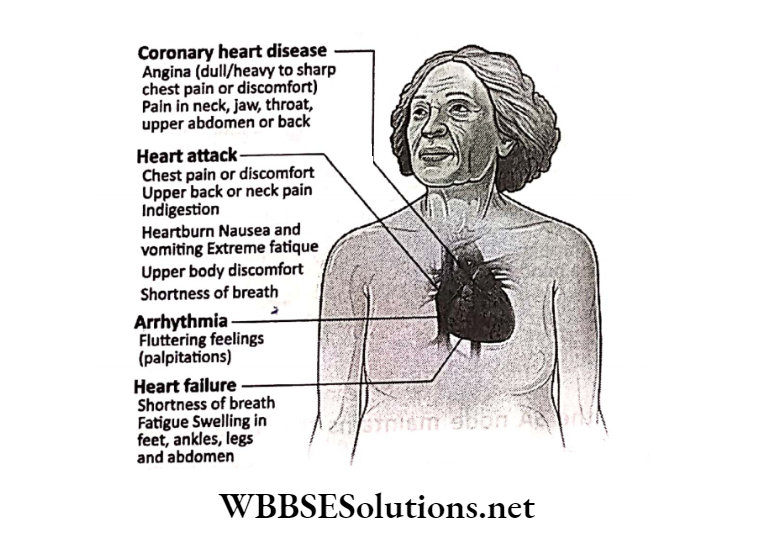
Here are some of the problems that go along with cardiovascular disease:
1. Arteriosclerosis:
Also called hardening of the arteries, arteriosclerosis means the arteries become thickened and are no longer flexible.
2. Atherosclerosis:
A buildup of cholesterol things a risk factor. Some of these risk factors a and fat which makes the arteries narrower, so less blood can flow through. Those buildups are called plaque.
3. Angina:
People with angina feel pain in the chest which means the heart muscle is not getting enough blood and oxygen.
4. Arrhythmia:
It is an irregular or abnormal er heartbeat. This can be a slow heartbeat en (bradycardia), a fast heartbeat (tachycardia), or an irregular heartbeat.
5. Heart attack:
When a blood clot or other blockage cuts blood flow to a part of the heart.
6. Ischemic heart disease:
A pathological condition of the heart muscle caused by lack of oxygen supply marked by pain and discomfort.
7. Heart valve disease:
It occurs when one or more of the four valves in the heart are not working properly. Heart valves help to ensure that the blood being pumped through the heart keeps flowing forward.
A disease of the heart valves (e.g., stenosis, mitral valve prolapse) makes it difficult for the heart to work efficiently.
8. Congenital heart disease:
It is a type of birth defect that causes problems with the heart at birth and occurs in about one out of every 100 live births.
Some of the most common types of congenital heart disease include atrial septal defects (ASD) and ventricular septal defects (VSD).
This occurs when the walls that separate the right and left chambers of the heart are not completely closed and consequently, there is a hole in the wall.
Babies born with congenital heart disease (ASD) may not have symptoms. When they grow up, adults may notice symptoms such as shortness of breath, heart palpitations, fatigue, swelling in the legs, feet, or abdomen, etc.
Symptoms of VSD include a bluish tinge to the skin, lips, and fingernails, along with poor feeding, poor weight gain, and fast breathing.
Heart disease is not contagious-we cannot catch it like we can the flu or a cold. Instead, certain things increase a person’s chances of getting cardiovascular disease.
Doctors call these people who can’t do anything about are like being older and having other people in the family who have had the same problems.
But people do have control over some risk factors smoking, having high blood pressure, being overweight, and not exercising can increase the risk of getting cardiovascular disease.
Chapter 8 The Human Body Blood
Know what blood is- It is that red stuff that oozes out if you get an open wound. The average person has about 4-6 liters of it.
But what is blood, really, and where does it come from?
Components of blood:
It is not made in a kitchen, but blood has ingredients, just like a recipe. To make blood, your body needs to mix:
- Red blood cells, which carry oxygen throughout the body,
- White blood cells, which fight infections,
- Platelets, which are cell fragments that help you stop bleeding if you get a cut, and
- Plasma is a yellowish liquid that carries nutrients, hormones, and proteins throughout the body.
- Your body does not go to the store to buy those ingredients. It makes them. Bone marrow, which is goopy stuff inside your bones, makes the red blood cells, the white blood cells, and the platelets.
Plasma is mostly water, which is absorbed from the intestine from what you drink and eat, with the liver supplying important proteins.
Put all these ingredients together and you have blood- an essential part of the circulatory system.
Thanks to your heart (which pumps blood) and your blood vessels through which blood travels throughout your body from your head to your toes. Let’s find out more about each ingredient.
1. Red blood cells (RBCs)
Red blood cells (also called erythrocytes) look like flattened basketballs. Most of the cells in the blood are red blood cells.
They carry around an important chemical called hemoglobin that gives blood its red color. Blood and breathing go hand in hand.
How? The hemoglobin in blood delivers oxygen, which you get from the air you breathe to all parts of your body. Without oxygen, your body couldn’t keep working and stay alive.
2. White blood cells (WBCs)
White blood cells (also called leukocytes) are bigger than red blood cells. There are usually not a whole lot of white blood cells floating around in your blood when you are healthy.
Once you get sick, your body makes some more to protect you. There are different types of white blood cells that do different things to keep you well.
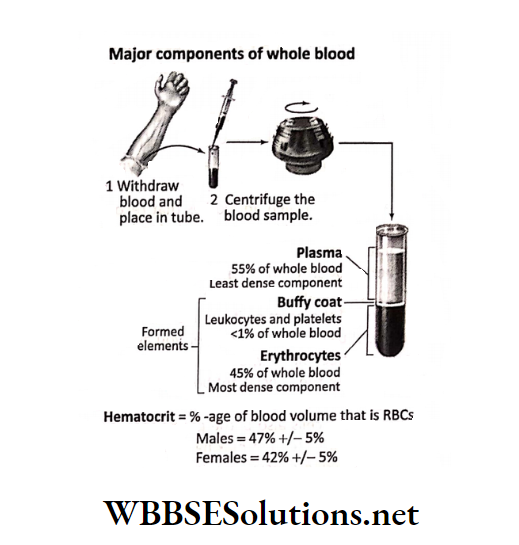
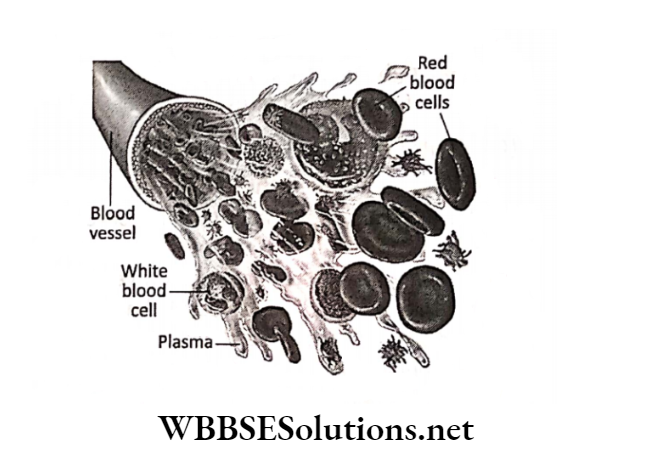
Granulocytes:
Do you know how your skin gets a little red and swollen around a cut or scrape? That means the granulocytes are doing their jobs.
They have a lot to do with how your body cleans things up and helps wounds heal after an injury.
Granulocytes also help to prevent infection by surrounding and destroying things that aren’t supposed to be in your body and by killing germs.
Granulocytes may be of three different types-Neutrophil, Eosinophil, and Basophil.
Agranulocytes: These are of two types- Lymphocytes and Monocytes.
1. Lymphocytes:
There are two types of lymphocytes:
B cells and T cells. B cells help make special proteins called antibodies that recognize stuff that should not be in your body, like bacteria or a virus you get from a sick friend.
Antibodies are, very specific, and can recognize only a certain type of germ. Once the antibody finds it, it gets rid of the germ so it cannot hurt you.
The really cool part is that even after you are better, B cells can become memory cells that remember how to make the special antibody so that if the same germ infects you again, it can kill the germ even faster.
T cells also battle germs that invade the body, but instead of making antibodies, they work by making special chemicals that help to fight the infection.
2. Monocytes:
Monocytes are white blood cells that fight infection by surrounding and destroying bacteria and viruses.
3. Platelets:
Platelets, also called thrombocytes, are tiny round cell fractions that help to make sure you do not bleed too much once you get a cut or scrape.
Cuts and scrapes break blood vessels. If a platelet reaches a blood vessel that’s been broken open, it sends out a chemical signal that makes other nearby platelets stick together inside the vessel.
After the platelets form this plug, they send out more chemical signals that attract clotting factors.
These clotting factors work together to make a web of tiny protein threads within which other blood cells too (RBCs and WBCs) are entangled.
The platelets and this web of protein together with other blood cells make a blood clot. The clot keeps your blood inside the vessel while the break in the blood vessel heals up.
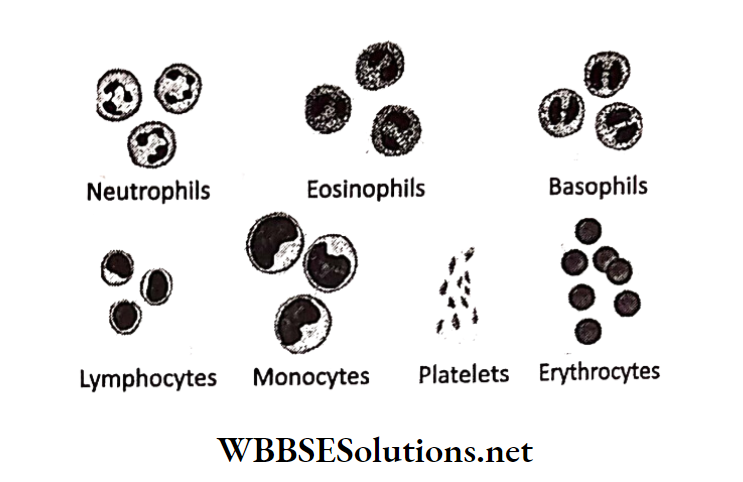
4. Plasma:
Plasma is a yellowish liquid that is mostly. water. But it also carries important nutrients, hormones, and proteins throughout the body.
Nutrients are chemicals from the food you eat that gives your body energy and other things your body’s cells need to do their work and keep you healthy.
Many proteins in plasma are really important to your body, like the clotting factors that help you stop bleeding if you get a cut or a scrape.
Plasma also carries away cell wastes- chemicals that the cell doesn’t want anymore.
Nutrients, hormones, proteins, and waste are dissolved in the plasma-kind of like the cocoa mix that dissolves in a cup of hot water. What are marshmallows? The blood cells-they float in the plasma.
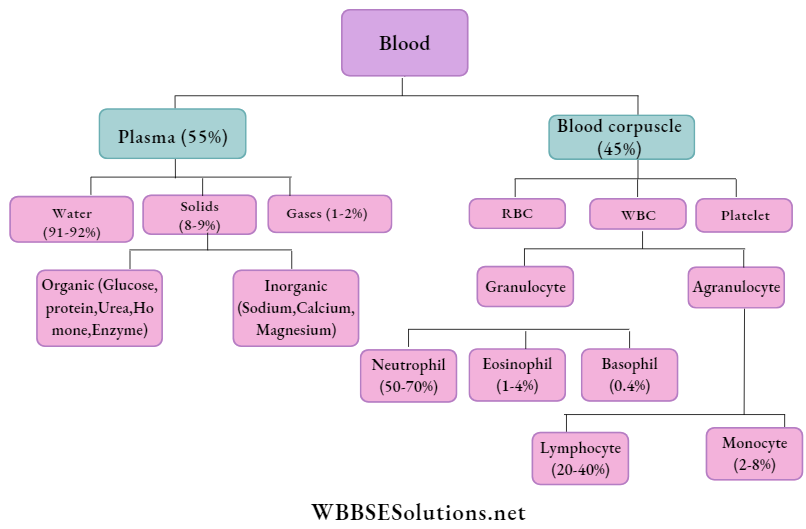
Blood Types:
Everybody’s blood is red, but it’s not all the same. There are eight blood types, described using the letters A, B, and O.
Those letters stand for certain proteins found in the red blood cells. Not everyone has the same proteins. In addition to getting a letter or two, a person’s blood is either “positive” or “negative”.
That doesn’t mean one person’s blood is good and another person’s blood is bad. It’s a way of keeping track of whether someone’s blood has a certain protein called Rh protein.
This protein is called “Rh” because scientists found it while studying Rhesus monkeys. If your blood is positive, you have this protein.
If it is negative, you do not. Either way is totally fine. Blood types are important if a person ever wants to donate blood or needs a blood transfusion. Getting blood of the wrong type can make a person sick.
The disease of the red blood cells:
The most common condition affecting the red blood cells of teens is anemia, a lower-than-normal number of red cells in the blood.
Anaemia is accompanied by a decrease in the amount of hemoglobin present in the blood.
Causes of anemia can be grouped into two categories anemia caused by insufficient RBC production and anemia caused by RBCs being destroyed too soon.
1. Diseases of platelets:
1. Thrombocytopenia, or a lower-than-normal number of platelets, is usually diagnosed because a person has abnormal bruising or bleeding.
2. Diseases of the clotting system:
The body’s clotting system depends on platelets as well as many clotting factors and other blood components.
If a hereditary defect affects any of these components, a person can have a bleeding disorder.
Diseases of the white blood cells:
- Neutropenia happens when there aren’t enough of certain types of white blood cells (neutrophils) to protect the body against bacterial infections.
- Human Immunodeficiency Virus (HIV) is a virus that attacks certain types of WBCs (lymphocytes) that work to fight infection.
Infection with the virus can result in AIDS (Acquired Immunodeficiency Syndrome), leaving the body prone to infections and certain other diseases. - Leukemias are cancers of the cells that produce WBCs.
Different types of WBCs defend the human body against the attack of micro-organisms. They collect at the site of infection and engulf the invaders.
WBC also manufacture antibodies that provide immunity to the body. Every day various microbes invade and enter the human body.
There are certain mechanisms through which these microbes are destroyed once they enter our bodies. The mechanism acts through discharge.
The flow of fluid from part of the body such as from the nose is called a discharge.
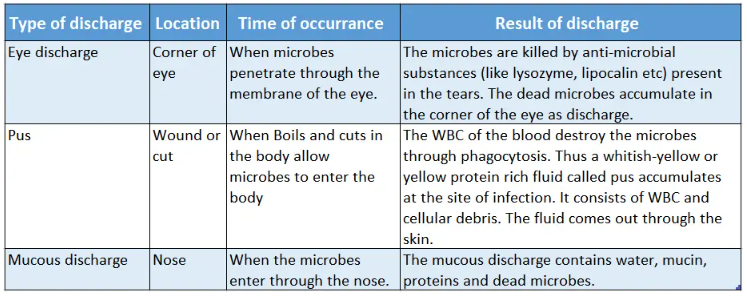
Chapter 8 The Human Body Lungs
Breathing air is necessary for keeping. humans (and many animals) alive. Your lungs make up one of the largest organs in your body, and they work with your respiratory system to allow you to take in fresh air, get rid of impure air, and even talk.
Location of lungs :
Your lungs are in your chest, and they are so large that they take up most of the space there. You have two lungs, but they aren’t of the same size as your eyes or nostrils.
Instead, the lung on the left side of your body is a bit smaller than the lung on the right. This extra space on the left leaves room for your heart.
Your lungs are protected by your rib cage, which is made up of 12 sets of ribs.
These ribs are connected to your spine in your back and go around your lungs to keep them safe.
Beneath the lungs is the diaphragm, a dome-shaped muscle that works with your lungs to allow you to inhale (breathe in) and exhale (breathe out) air.
You can’t see your lungs, but it’s easy to feel them in action: Put your hands on your chest and breathe in very deeply. You will feel your chest getting slightly bigger.
Now breathe out the air, and feel your chest returning to its regular size.
Structure of lungs :
From the outside, the lungs are pink and a bit squishy, like a sponge. At the bottom of the trachea, or windpipe, there are two large tubes.
These tubes are called the main stem bronchi, and one heads left into the left lung, while the other heads right into the right lung.
Each main stem bronchus is the name for just one of the bronchi-then branches off into tubes, or bronchi, which get smaller and even smaller still, like branches on a big tree.
The tiniest tubes are called bronchioles, and there are about 30,000 of them in each lung. Each bronchiole is about the same thickness as a hair.
At the end of each bronchiole is a special area, that leads into clumps of tiny air sacs called alveoli.
There are about 600 million alveoli in our lungs and if we stretch them out, they would cover an entire tennis court.
Each alveolus-what we call just one of the alveoli- has a mesh-like covering of very small blood vessels called capillaries.
These capillaries are so tiny that the cells in your blood need to line up a single file just to march through them.
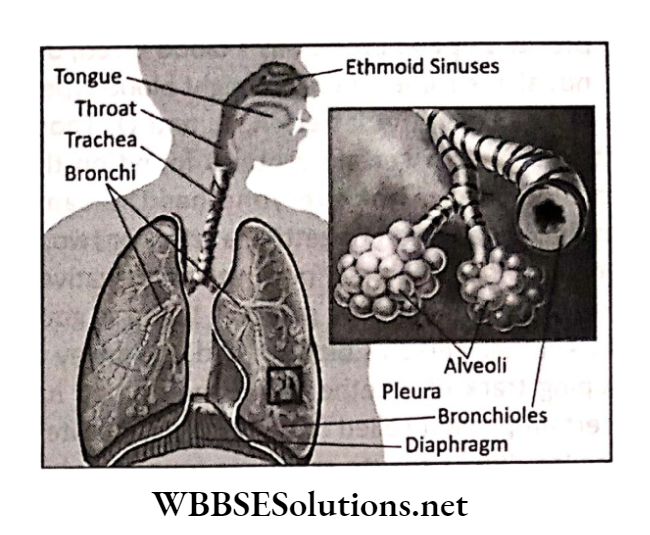
Functioning of lungs:
When you are walking with your pet, cleaning your room, or playing football, you probably do not think about inhaling (breathing in)-you have got other things on your mind.
But every time you inhale air, dozens of body parts work together to help get that air in there without you ever thinking about it.
As you inhale or breathe in, your diaphragm contracts and flattens out. This allows it to move down, so your lungs have more room to grow larger as they fill up with air.
“Move over, diaphragm, I’m filling up!” is what your lungs would say. And the diaphragm is not the only part that gives your lungs the room they need.
Your rib muscles also lift the ribs up and outward to give the lungs more space. At the same time, you inhale air through your mouth and nose, and the air heads down your trachea or windpipe.
On the way down the windpipe, tiny hairs called cilia move gently to keep mucus and dirt out of the lungs.
The air then goes through the series of branches in your lungs, through the bronchi and the bronchioles.
The air finally ends up in the 600 million alveoli. As these millions of alveoli get filled up with air, the lungs get bigger. It’s the alveoli that allow oxygen from the air to pass into your blood.
All the cells in the body need oxygen every minute of the day. Oxygen passes through the walls of each alveolus into the tiny capillaries that surround it.
The oxygen enters the blood in the tiny capillaries, hitching a ride on red blood cells and traveling through layers of blood vessels to the heart.
The heart then sends the oxygenated (filled with oxygen) blood out to all the cells in the body.
When it’s to exhale (breathe out), everything happens in reverse. Now it’s the diaphragm’s turn to say, “Move it!” Your diaphragm relaxes and moves up, pushing air out of the lungs.
Your rib muscles become relaxed and your ribs move in again, creating a smaller space in your chest.
By now your cells have used the oxygen they need, and your blood is carrying carbon dioxide and other wastes that must leave your body.
The blood comes back through the capillaries and the wastes enter the alveoli.
Then you breathe them out in the reverse order of how they came in the air goes through the bronchioles, out the bronchi, out the trachea, and finally out through your mouth and nose.
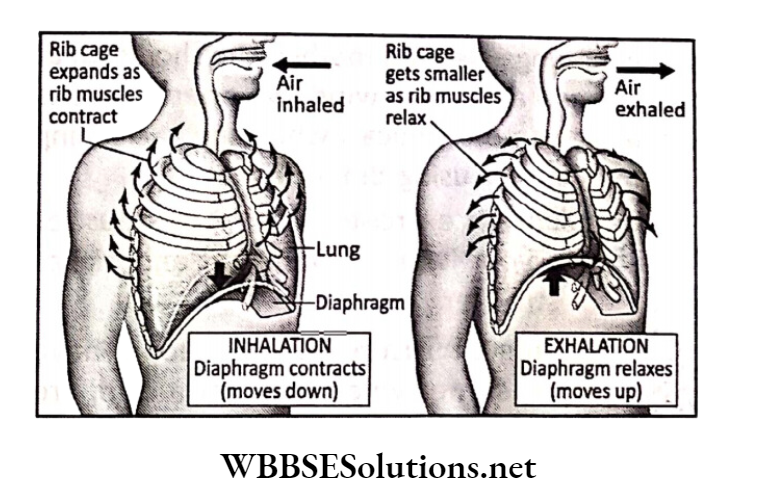
The air that you breathe out not only contains waste and carbon dioxide, but it’s warm too art balls and to me Sequence As air travels through your body, it picks up heat along the way.
You can feel this heat by putting your hand in front of your mouth or nose as you breathe out. With all this movement, you might be wondering why things don’t get stuck as the lungs fill and empty.
Luckily, your lungs are covered by two really slick special layers called pleural membranes.
These membranes are separated by a fluid that allows them to slide around easily while you inhale and exhale.
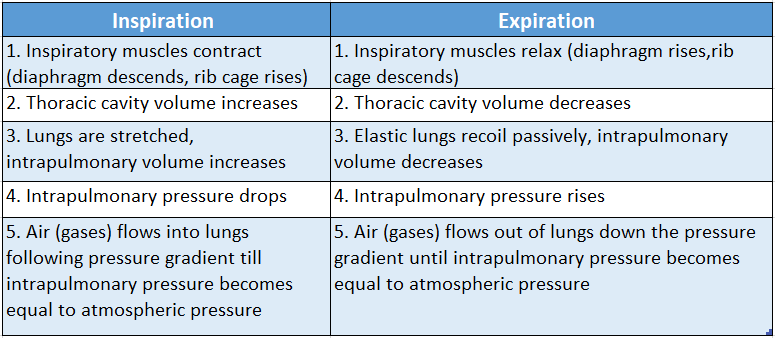
Talking:
Your lungs are important for breathing and also for talking. Above the trachea (windpipe) is the larynx, which is sometimes called the voice box.
Across the voice box are two tiny ridges called vocal cords, which open and close to make sounds. When you exhale air from the lungs, it comes through the trachea and larynx and reaches the vocal cords.
If the vocal cords are closed and the air flows between them, the vocal cords vibrate and a sound is made.
The amount of air you blow out from your lungs determines how loud a sound will be and how long you can make the sound.
Very deeply and saying the names of all the kids in your class-how far can you get without taking the next breath? The next time you’re outside.
Try shouting and see what happens- shouting requires lots of air, so you’ll need to breathe in more frequently than you would if you were only saying the words.
Take care of your lungs :
- Do not smoke and keep away from others who smoke. Lungs do not like cigarette smoke, it can damage them, and cause disease and even death.
Stay out of the workshop if someone is using chemicals, as some chemicals can damage your lungs. - Remind mother, she should wear a mask and have windows open if she is using some chemicals when she is cleaning the oven or using drain cleaner.
- Get plenty of exercise. It makes the muscles around your lungs work harder and makes them stronger.
Problems of lungs:
Some people have asthma. Sometimes when they get a cold, are in contact with something they are allergic to, or exercise hard, the tiny tubes in their lungs get tighter and there is a lot more mucus.
This makes it hard to get air into the alveoli. They can become very short of breath and need medication to help their lung work well.
Illnesses like bronchitis and pneumonia also make it hard for air to get into the alveoli.
When the lungs do not work well, that means there is not enough oxygen getting around to all the cells of the body, and the body systems do not work as well as usual and you feel short of breath.
People affected with Tuberculosis spit blood while coughing, and suffer from mild fever (especially at night), respiratory trouble, and chest pain.
Severe weakness is felt and loss of body weight takes place rapidly.
Chapter 8 The Human Body Bones, Bone-Joints, and Muscles
Every time you move your body from place to place, your bones, muscles, and joints are working together. The bones that make up your skeletal system provide shape and protection.
Your skull protects your brain, your backbones protect your spinal cord and your ribs protect your heart and lungs.
Wherever two bones meet, there is a joint to hold them together and allow them to move, but there would be no movement without the 650 muscles that make up your muscular system.
Bones form the structural framework for our body, while muscles are responsible for pulling the joints, allowing us to move.
The cartilage, muscles, ligaments, and tendons, all work as one, holding bones together and letting joints move. Muscles connect the joints to the bones.
Flexing of the muscles and the ability to bend at the joints moves the bones to accomplish skilled body motions.
1. Bones
Bones make up the framework of our bodies. We call this framework the skeleton. Bones are living, growing, and changing parts of our bodies.
Baby skeletons are made up of more than 300 parts, but by the time we become adults we only have 206 bones. No, we don’t lose any.
It’s just that some of our baby bones are made, partly or completely, of cartilage. As we grow bigger and heavier, cartilage is slowly replaced by harder bone.
Some smaller bones are joined together to make one bigger bone.
Bones are largely made of calcium and other minerals. They are hard enough to support our weight and daily stress. Bones protect our major organs and give our bodies shape.
Bones are actually living tissue. The center of the bone, or marrow, is where your blood is created.
Parts of bones: Most bones have 4 parts:
- The outside part of the bone is called the periosteum. This is a thin but very dense layer that has the nerves and blood vessels which nourish the bone.
- Compact bone is next. It is smooth and very hard.
- Cancellous bone comes next and this looks a bit like a sponge but is much stronger.
- On the very inside of many bones is the bone marrow. It looks a bit like a jelly and it makes new blood cells for the body.
Functions of bones:
- The bones of the skeleton give us our shape and our posture. Without our spine (backbone) and leg bones, we would be unable to stand erect. Bones also protect the softer parts of our bodies.
- The skull is like a natural helmet that protects the brain.
- The spine protects the nerves in the spinal column.
- The rib makes a shield around our lungs and heart.
- They act as a base for muscles, ligaments, and tendons. Ligaments connect bones to bones and tendons connect muscles to bones.
- They all work together to help us move around.
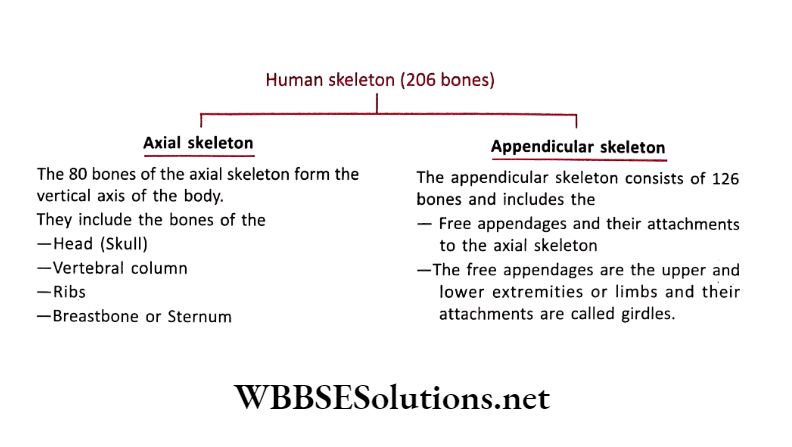
Different major bony parts of our body
- Some bones protect the brain. You can feel the bone at the back of your head and forehead.
- Some bones make the framework for your face. You can feel the bones around your eyes.
- Some bones in the middle part of your ear carry sound from your eardrum to the inner De ear.
- You can feel the jawbone under your chin and where it hinges just under your ear. It is the only bone in your skull that you can move.
2. Spine (Vertebral Column)
The spine has 26 bones which are like circles with wings on the sides and back. They are called vertebrae. There are small discs made of cartilage between each vertebra.
They act like shock absorbers and stop the bones from rubbing against each other. There is also a hole through each of the vertebrae where the spinal cord goes.
- The top 7 are called the cervical vertebrae and they support your head and neck.
- The next 12 are called the thoracic vertebrae. These hold one end of your ribs.
- The next 5 are the lumber vertebrae.
- The next, the sacrum, is a large bone that is actually made of 5 vertebrae fused (joined) together.
- At the bottom of the spine is the coccyx, which is one bone made of 4 small vertebrae fused together.
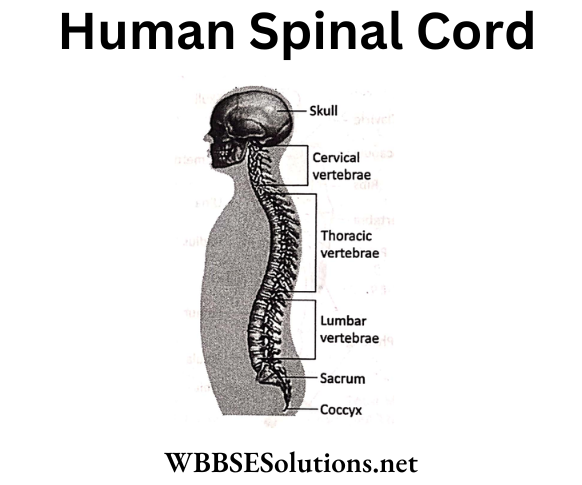
3. Ribs
Ribs make a protective cage around your lungs and heart. There are usually 12 pairs of ribs, each pair attached to the spine at the back.
Each rib is attached to the ribs above and below it by muscles and ligaments.
- At the front of the body, the top 7 ribs are attached to the sternum (or breast bone).
- The next 3 pairs are joined to the ribs above and to the sternum, by cartilage.
- The last 2 pairs of ribs are called the ‘floating’ ribs. They are called floating because they are attached only to the vertebrae and not to the sternum. They don’t have sharp edges sticking out.
4. Arms
Each arm is fastened to the scapula (the shoulder blade) at the back, (which is a triangle-shaped bone near the top of the ribs) and to the clavicle at the front (the collar bone).
The arm has 3 bones-the humerus, the radius, and the ulna. The humerus is the bone between your shoulder and the elbow.
The radius and ulna bones go from the elbow to the wrist. At the end of the radius and ulna is your wrist. Your wrist has 8 small bones, so it is really flexible. In each hand, there are 19 bones.
5. Legs
Your legs are fastened to your pelvis at the hips. The pelvis is shaped like a bowl and supports the contents of your tummy.
- Legs need to be large and strong to support something to pull them. This job is done by the rest of the body.
- The femur is the largest bone in the body and it goes from the pelvis to the knee.
- Another bone called the patella, or kneecap covers the knee joint to protect it.
- Below the knee, there are 2 bones. These are the tibia and the fibula. They join up to a large bone in the ankle called the talus.
- There are 6 other bones here so you can move your ankle around but you cannot move it as much as you can move your wrist. Your feet and ankles have a total of 52 bones in them.
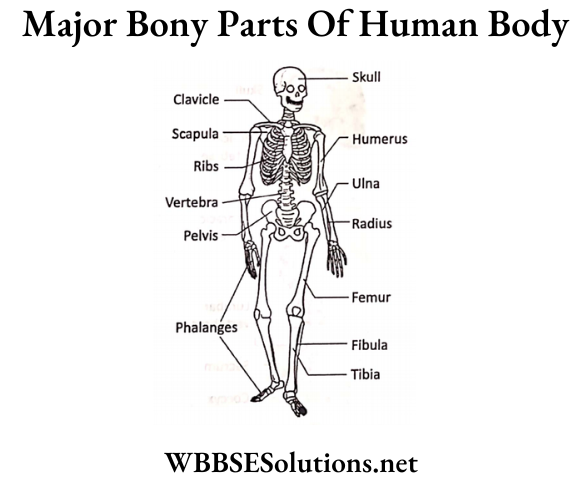
Common orthopedic problems:
Anything that is concerned with muscles, ligaments, and joints is considered orthopedic. Some common problems are
- Arthritis is a rheumatic disease that has symptoms of pain, limited movement, swelling, and pain in connective tissues.
- Osteoarthritis is a degenerative joint disease that middle-aged and older adults experience. The joint cartilage breaks down with the progress of your age and it can occur in the hands, knees, spine, or hips.
- Rheumatoid arthritis is a disease listed in the orthopedic section that causes severe inflammation of the joints. joints. The inflammation is so severe that the functioning of the extremities becomes severely limited.
- Fractures are definite orthopedic problems.
- Low back pain is an orthopedic condition that affects one in ten people. Low back pain presents from mild and annoying to persistent and severe.
- Neck pain can come from injuries or damage to the muscles and ligaments of the neck, a herniated cervical disk of arthritis.
2. Bone Joints
The human body moves in many different ways. You can bend, stretch, turn, and twist. You can move because your bones move at your joints, places where your bones meet.
But your bones can’t move by themselves-they need muscles, which are joined to your bones in order to move them.
There are many joints that help your body move. When you turn your head, bend your knees, or twist your wrists, your joints are in action. Some joints, such as those in your skull, do not move.
These are called fixed joints. Each of the other kinds of joints does a specific type of movement.
What are joints? Joints are places where bones meet. The study of joints is called “arthrology”, which is derived from the Greek words “Atheros” meaning joint, and “logos” meaning study.
One bone can have two or more joints. An example is your jaw or mandible. It is connected to the temporal bones on either side of your skull.
You can feel these joints when you place your hands on the junction of your cheeks and your ears and simulate chewing motions.
What are the functions of your joints:
Aside from smooth movement, joints also have other functions. They allow you to grow. When your brain grows, the sutures in your skull accommodate.
The primary cartilaginous joints of your knees and elbows allow you to grow to your full height. Joints also serve to minimize friction and cushion the bones against impact.
Joints are very important areas in your body. They give you space for growth and allow you to move the way you want.
What are the classifications of joints:
Joints can be classified according to what material unites the bones. The three main types of joints are fibrous joints, cartilaginous joints, and synovial joints.
Fibrous joints are joined by fibrous tissue cartilaginous joints are united by cartilage or a mix of cartilage and fibrous tissue; synovial joints are connected by a synovial membrane that surrounds the joint cavity.
1. Fibrous joints:
The movement allowed by these joints is dependent on the length of the fibrous tissue connecting the bones. In the skull, these joints are called sutures.
Sutures are connected by strong connective tissues and allow very little or no movement in adults. These are known as immovable joints.
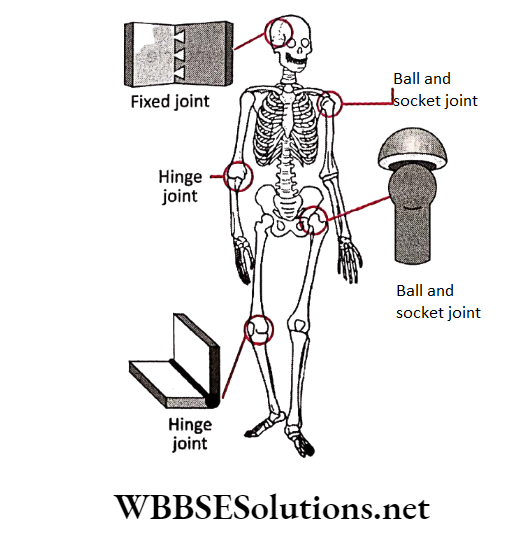
2. Cartilaginous joints:
These joints can be primary cartilaginous joints and secondary cartilaginous joints. Primary cartilaginous joints are connected by cartilage temporarily, early in life.
An example is your knee joint. Later on, the cartilage becomes bone. Secondary cartilaginous joints. consist of bones with the ends covered by cartilage and connected with fibrous. tissue.
These joints are found in the vertebral column and allow slight movement. These are known as partly movable joints.
3. Synovial joints:
These joints are present in the shoulder, hip, knee, ankle, toes, elbow, and the joints of the limbs including the loot fingers.
Their name is derived from the fact sling that they have synovial fluid and is du enclosed within a synovial capsule.
joints allow considerable movement but have ligaments to prevent excessive movement. These are known as movable lee joints.
What are the types of synovial joints?
Synovial joints can be categorized into six types based on the movement they allow. The first type, a plane joint, allows gliding or sliding movement, and the bones involved usually have flat surfaces.
An example of a plane joint is found in the shoulder, between the shoulder blade (acromion of the scapula) and the clavicle.
A hinge joint can move in the axis at a right angle to the joints involved. An example is the elbow joint, which connects the humerus and the ulna.
The movement allowed by this joint includes flexion (bending) and extension (straightening) of your elbow.
The third type of synovial joint is the condyloid joint.
In Greek, “condyloid” means knuckle-like. This type of joint allows movement in two axes. Therefore you can bend it, straighten it, move it from side to side, and rotate it.
An example is your wrist joint. song yen send scrawled The fourth synovial joint type is the saddle joint.
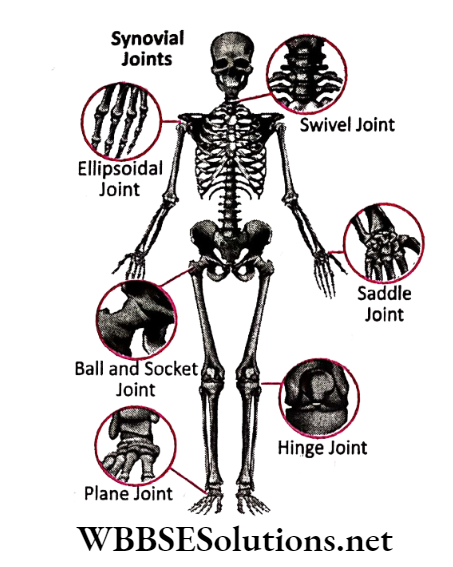
This joint is so-named because the opposing surfaces of the involved bones look like a saddle-one has a convex surface, while the other has a concave surface.
The thumb joint, which can also move in two axes, is a good example of this joint.
Ball and socket joints are perhaps the most versatile synovial joints. They are multi-axial joints, which means they can move in many axes. One joint has a ball and the other joint has a socket.
The shoulder joint and the hip joints are examples of this type. In the hip joint, the ball is the head of the leg bone (femur) while the socket is the acetabulum of the hip (pelvis).
Try to experiment with the kinds of movement you can make with your hip joint. You can bend, flex, open, close, rotate and circularly move your legs.
These movements of the hip joint are very important for ballerinas and dancers who have complex leg routines.
The last type of synovial joint is the pivot joint. These joints only allow rotation. One bone serves like a ring while the other bone has a rounded process rotating within the ring.
This type is found in your neck, particularly in your first two cervical bones called the atlas (the ring) and the dens (the rounded process). This allows you to rotate your head.
Problems of bone joints:
Joints form the connections between bones. They provide support and help you move. Any damage to the joints from disease or injury can interfere with your movement and cause a lot of pain.
Joint pain can be caused by injury affecting any of the ligaments, bursae, or tendons surrounding the joint. Injury can also affect the ligaments, cartilage, and bones within the joint.
Many different conditions can lead to painful joints including osteoarthritis, rheumatoid arthritis, bursitis, gout, strains, sprains, and other injuries. Joint pain is extremely common.
Joint pain can range from mildly irritating to debilitating. It may go away after a few weeks (acute), or last for several weeks or months (chronic).
Even short-term pain and swelling in the joints can affect your quality of life. Whatever the cause of joint pain, you can usually manage it with medication, physical therapy, or alternative treatments.
3. Muscles
Did you know you have more than 600 muscles in your body? They do everything from pumping blood throughout your body to helping you lift your heavy backpack.
You control some of your muscles, while others–like your heart- do their jobs without you thinking about them at all.
Muscles are all made of the same material, a type of elastic tissue (sort of like the material in a rubber band). Thousands or even tens of thousands of small fibers make up each muscle.
Types of muscles:
You have three different types of muscles in your body: smooth muscle, cardiac muscle, and skeletal muscle.
1. Smooth muscles or Involuntary muscles
Smooth muscles-sometimes also called involuntary muscles-are usually in sheets, or layers, with one layer of muscle behind the other. You cannot control this type of muscle.
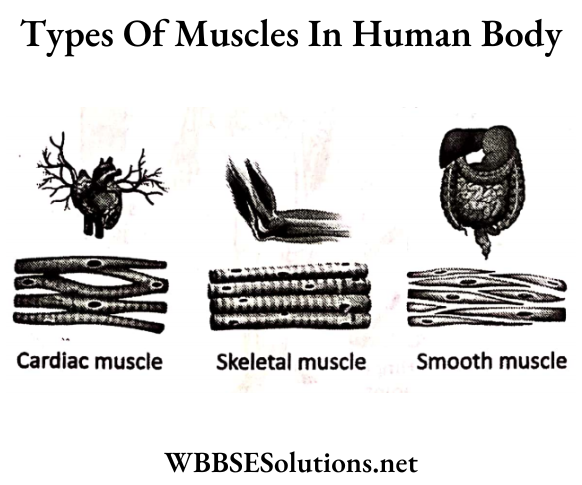
Your brain and body tell these muscles what to do without you even thinking about it. But smooth muscles are at work all over your body.
In your stomach and digestive system, they contract (tighten up) and relax to allow food to make its journey through the body. Smooth muscles are also found in your bladder.
When they are relaxed, they allow you to hold in urine until you can get to the bathroom. Then they contract so that you can push the urine out.
2. Cardiac muscles
The muscle that makes up the heart is called cardiac muscle. It is also known as the myocardium. The thick muscles of the heart contract to pump blood out and then relax to let blood in after it has circulated through the body.
Just like smooth muscle, cardiac muscle works all by itself with no help from you. A special group of cells within the heart are known as the pacemaker of the heart because it controls the heartbeat.
3. Straited muscles or Voluntary muscles
Now, let’s talk about the kind of muscle you think of when we say “muscle”-the ones that show how strong you are and let you boot a soccer ball into the goal.
These are your skeletal muscles-sometimes called striated muscles because the light and dark parts of the muscle fibers make them look striped. are voluntary muscles, which means you can control what they do.
Your leg will not bend to kick the soccer ball unless you want it to. These muscles help to make up the musculoskeletal system-the combination of your muscles and your skeleton, or bones.
Skeletal muscles are held to the bones with the help of tendons Tendons are cords made of tough tissue, and they work as special connector pieces between bone and muscle.
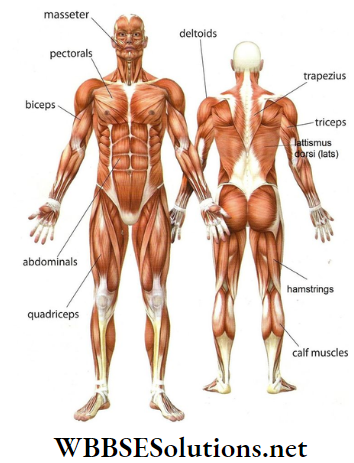
The tendons are attached so well that when you contract one of your muscles, the tendon and bone move along with it.
Skeletal muscles also give your body the power it needs to lift and push things. Muscles in your neck and the top part of your back aren’t as large, but they are capable of some pretty amazing things.
Try rotating your head around, back and forth, and up and down to feel the power of the muscles in your neck. These muscles also hold your head high.
How do muscles work? Muscles work by expanding and contracting. Muscles have long, thin cells that are grouped into bundles.
When a muscle fiber gets a signal from its nerve, proteins, and chemicals release energy to either contract the muscle or relax it.
When the muscle contracts, this pulls the bones it’s connected to, closer together. Many of our muscles come in pairs. An example of this is the biceps and triceps in our arms.
When the biceps contract the triceps will relax, which allows our arm to bend. When we want to straighten our arm back out, the biceps will relax and the triceps will contract.
Muscle pairs allow us to move back and forth. Caring muscles Muscles get most of their energy from glucose.
Glucose is made from several types of carbohydrates such as sucrose (which is usually called sugar), lactose (from milk), or fructose (from fruits).
When muscles need to get energy from glucose they do this by changing the glucose into other chemicals such as water and carbon dioxide which release the energy.
We sometimes call this ‘burning’ glucose. They use the oxygen being carried in the blood to help them do this.
Muscles need to move to remain healthy and strong. You can help your muscles stay strong and healthy by exercising every day and using moms have different sets of muscles when they exercise.
When you exercise a lot, your muscles become tired from all the contracting and relaxing. Your muscles might get hurt then.
Have you ever had a cramp? This is when your muscles seem to lock up, and you have a pain in your foot or your leg, or a ‘stitch’ in your side.
This happens when one or more of your muscles contract and will not relax again (called a spasm).
Sweating and not drinking enough on a hot day may mean that you are more likely to get a muscle cramp.
Try drinking water, and stretching and massaging the muscle that hurts and it will get better.
Diseases that can affect muscles: Polio is a virus that attacks the spinal cord. The brain can’t send messages to the muscles and they stop working.
Not long ago a lot of kids would catch this illness, but nowadays not many people get poliomyelitis (that’s its full name) because kids are given an immunization against it.

Tetanus also affects muscles and kids have already had ‘shots’ to stop them from getting this too. There are some other diseases that can affect muscles.
If a person spends long hours in front of a computer then he may sustain injuries from occupational poor posture. The most common such injuries are
- Mouse shoulder.
- Computer back
- Lumbar strains and sprains
- Disc injuries
- Tennis elbow.
Chapter 8 The Human Body The Growth And Development Of The Human Body
There are clear stages that children pass through from birth to adulthood. These stages are the same for boys and girls, but girls generally mature before boys. This is clearly shown in the diagram below.
Physical development:
Physical growth is obviously important to performance. We will start by looking at how the body changes during development.
There are important changes in body size and proportions. These changes affect the way where children can perform different skills and activities. our gas Patterns of growth ou mot varans
1. Changes in size
Children grow in size at a very fast rate. At birth, infants are only about a quarter of their adult height.
This final adult height is usually reached at about twenty years of age. There are four characteristic stages of growth from birth to adulthood.
- Rapid growth in infancy and early childhood
- Slow, steady growth in middle childhood
- Rapid growth during puberty bow sort
- Gradual slowing down of growth in adolescence until adult height is reached. Both sexes are of comparable shape and size during infancy and childhood.
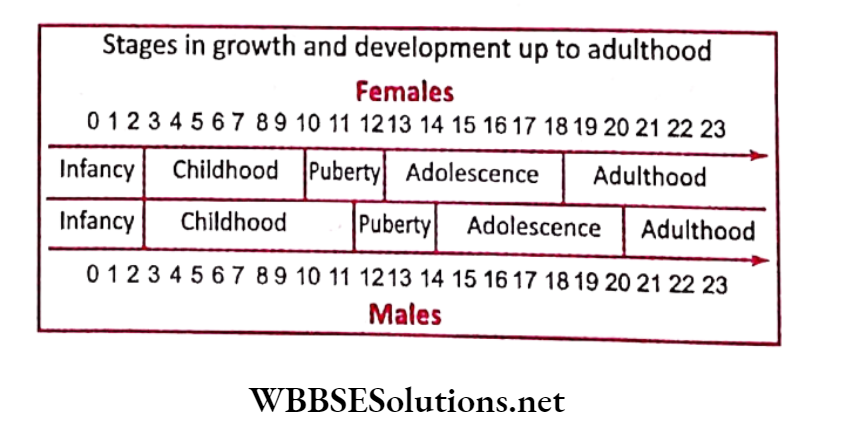
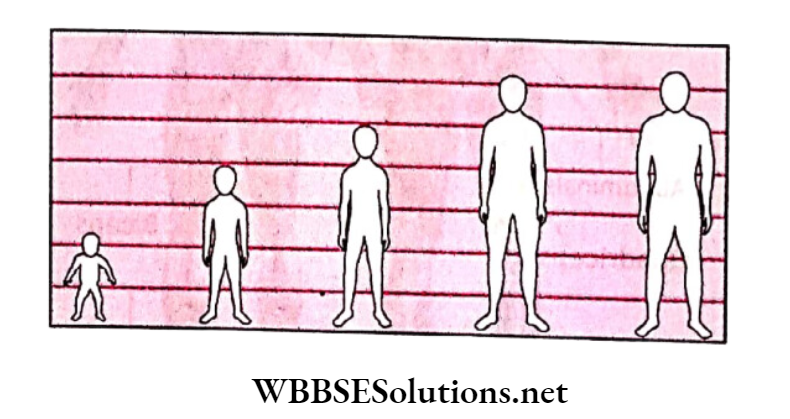
2. Changes in proportions
The physical proportions of the body at birth are very different from those of the adult. Some body parts grow more than others during g development to each of the final adult proportions.
The illustration shows the relative size of body parts at different ages. The head is proportionally large and the legs are proportionally short during childhood.
At birth, the head is one-quarter of the length of the body compared with about one-sixth in the adult. The legs are about one-third the length of the body at birth and one-half in the adult.
Because the body proportions change this means that not all of the body segments grow by the same amount.
Changes in the size and shape of the body. are caused by different segments growing at different times.
These changes in body proportions will have a great influence on how skills will be performed.
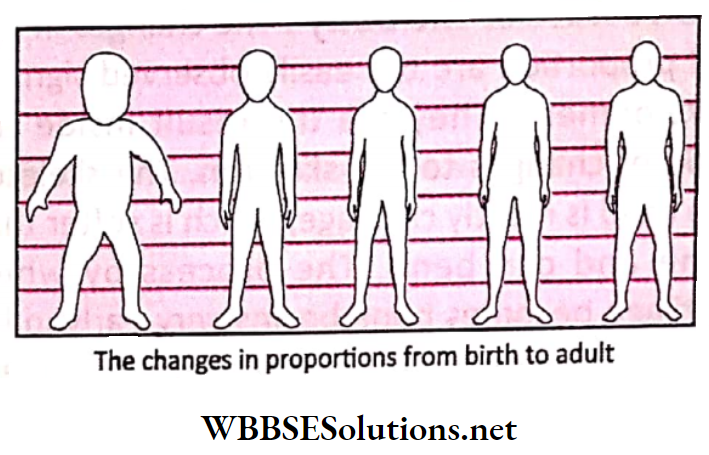
For example, changes in the relative size of the head in childhood affect the balance of the body during movement and the relative shortness of the legs at a very young limit running ability.
At the beginning of puberty, children have long arms and legs. They are better suited for running but the rapid growth may make them appear to be clumsy and to have difficulty in coordination.
Nous Growth spurts:
When the rate of growth increases rapidly it is called a growth spurt. The most important growth spurt is the one that occurs at puberty. This spurt produces a rapid increase in both weight and height.
The peak of this growth spurt occurs at about age 12 for girls and age 14 for boys. Before this growth spurt, there are no important differences between boys and girls in weight and height.
During growth spurts, most of the child’s energy is used for growing.
Children will be easily tired and may not be able to keep up their usual Birth to 1 year to puberty Adolescence growth of trunk growth of legs growth of trunk Areas of growth volume or intensity of training.
Light training will stimulate bodily growth if the child has enough energy.
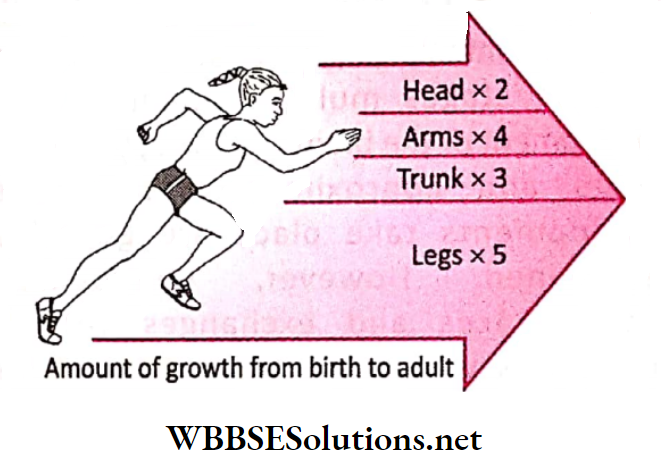
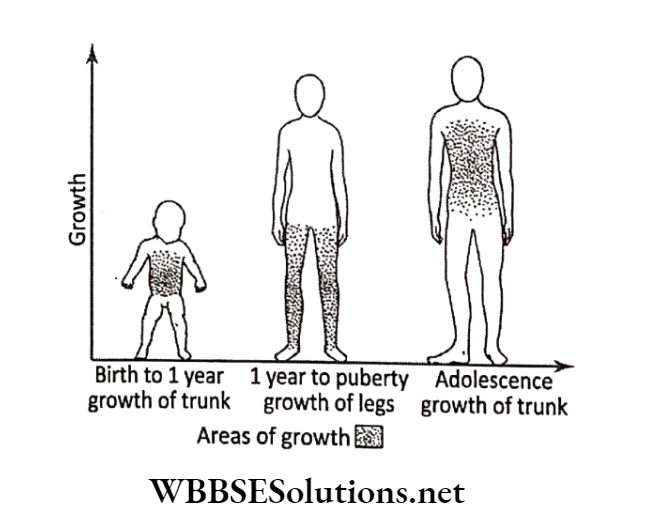
Difference between boys and girls:
The growth spurt and puberty occur at different ages for girls and boys. Girls usually start and finish the stages of puberty and adolescence earlier than boys.
The characteristic differences between boys and girls occur at puberty in response to changes in hormones produced by shoulders and little change in hip width in boys’ bodies.
Typically, this results in broader and broader hips and little change in shoulder width in girls.
Structure of the body:
The changes in size and proportion are easily observed signs of development. They are the result inside the body of changes to the skeleton.
The skeleton of a child is mostly cartilage, which is softer than bone and can bend. The process by which cartilage becomes bone begins very early in life in special growth areas in the bones.
These special growth areas are called growth plates.
Psychological development:
Children go through distinct periods of development as they move from infants to young adults. During each of these stages, multiple changes in the development of the brain are taking place.
What occurs and approximately when these developments take place are genetically determined.
However, environmental circumstances and exchanges with key individuals within that environment have a significant influence on how each child benefits from each development event.
Ages and stages is a term used to broadly outline key periods in the human development timeline.
During each stage growth and development occur in the primary developmental domains including physical, intellectual, language, and social-emotional.
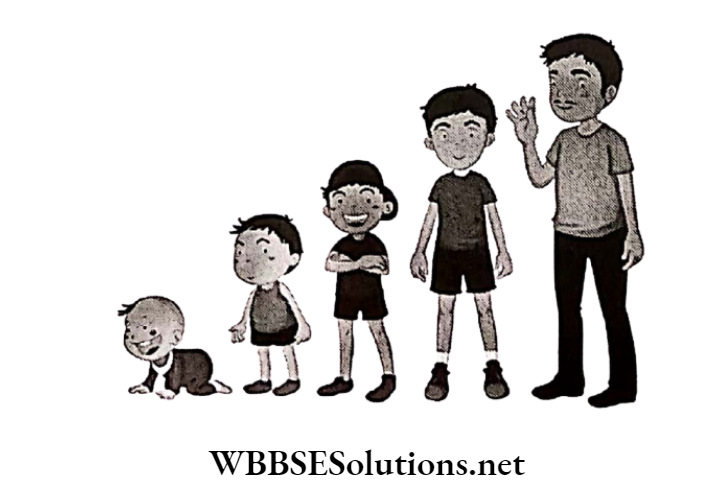
1. Infants/Babies (0-2 years)
This is a time for developing the bonds that will last a lifetime providing the child with the inner resources to develop self-esteem and the ability to relate positively with others.
2. Toddlers/Pre-schoolers (2-5 years)
When a child takes the first step on his or her own, a new phase in development begins. At this stage, children are now free to roam around the world.
It is a time for active exploration of their environment.
Language development takes major leaps which leads to learning the names of objects of interest, the ability to ask for things, and as they discover their independent nature.
During this developmental stage, a major challenge is developing what psychologists call emotional regulation.
This is also a stage of rapid physical and intellectual development preparing these children for starting school which includes interacting cooperatively with peers while at the same time being able to compete physically and intellectually.
3. School-age children (6-12 years)
While toddlers and pre-schoolers need constant supervision, school-age children become gradually ready for more independence.
However, learning to make good choices and exercise self-discipline does not come easily for many. Parents need to impart a moral code that the child gradually internalizes.
As children struggle with these important tasks parents must be able to provide praise and encouragement for achievement but parents must also be able to allow them to sometimes experience the natural consequences for their behavior or provide logical consequences to help them learn from mistakes.
4. Adolescents/Teenagers (13-18 years)
It is a time to really begin defining one’s self and realistically contemplating the future. Skill development is accelerated to prepare for college or job training programs.
Talents are perfected. Social skills are honed and relationships take on more of a serious nature. Peer pressure is at its maximum and in today’s teen society there are more tempting sidetracks than ever.
During adolescence, kids need their parents more than ever.
With age, children grow both in weight and height. Their rates of growth are not uniform throughout the whole of childhood.
Growth in the first few years of life is very rapid, and then it slows down later.
Another spurt of growth their birth weight at 5 months and treble it at 1 takes place in adolescence. Most babies have a double year.
While the average length of the baby at birth is about 50 cm (20 inches), it rises to 75 cm (30 inches) at 1 year, i.e., one and a half times more than at birth.
Boys, even in infancy, tend to be taller, heavier and grow faster than girls do. There is a lot of difference in height and weight of children at different ages.
There are also significant variations in the height and weight of children from different regions and communities in a vast and diverse country like India.
The expected average weight and height of Indian children of different ages are given below:
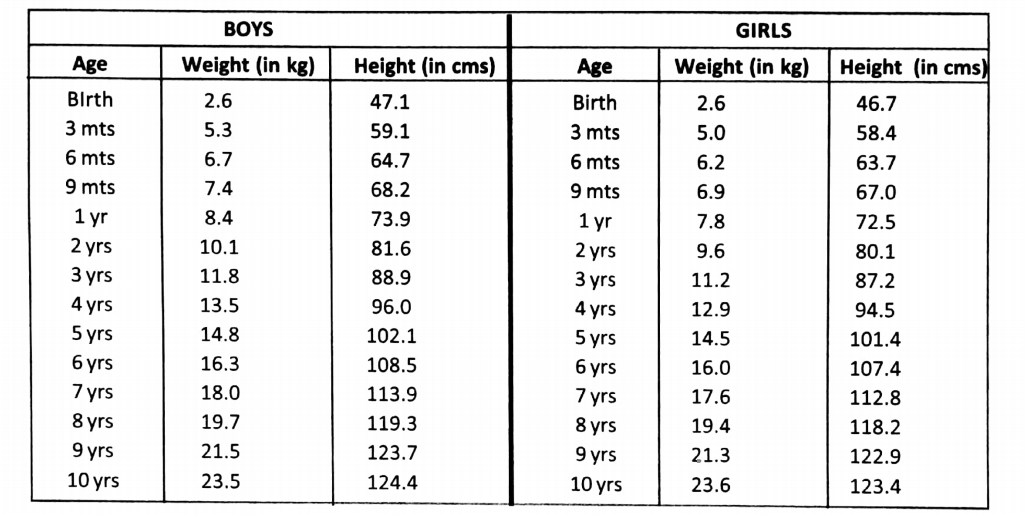
Abnormal development:
Fairy tales are filled with stories of giants and little people. The stories were written hundreds of years ago, and they sometimes tried to explain why these people looked different from others around them.
These old-fashioned fairy tales might have been different if the writers had known what today’s doctors have learned about growth.
What is Growth Disorder? Everyone grows and matures differently. You may be taller than your best friend in fourth grade. But then in sixth grade, your best friend may be an inch taller than you.
Usually, this is totally normal. A growth disorder, however, means that a kid has abnormal growth-for example, growing a lot slower or a lot faster than other kids at the same age.
What is Normal Growth? If growth is not the same for all kids, how do doctors know what is normal? By feet and inches (or meters and centimeters).
Over the years, lots of height and weight measurements have been taken for lots of children of different ages.
These measurements have been put together in what is called a standard growth chart, which tells doctors about how most kids grow.
From the time you were a baby; your doctor has weighed and measured you whenever you have had a checkup.
Because kids grow differently, your doctor checks your height against the standard growth chart.
If you are in the 50th percentile on the growth chart, it means half of the kids of your age are taller than you are and half are shorter.
If you fall in the 25th percentile that means 75% of the kids of your age are taller and 25% are shorter, and so on.
But some children who are under the 3rd percentile or over the 97th percentile, or who are growing a lot slower or faster than most other kids, may have a growth problem. In this situation, the doctor will usually want to check things out.
One thing your doctor will want to know is how tall your mother and father are and how they grew when they were children.
You may have inherited short or tall genes from them. You may also have inherited the tendency to have your growth spurt earlier or later than most other kids do.
Problems with puberty:
Glands in your body produce chemical messengers called hormones. Normal increases in the amounts of some of these hormones being produced trigger the changes your body goes through during puberty.
Puberty is the stage of your life when sexual development happens, like breast development and menstrual periods in girls and growth of the penis and testicles in boys.
One of the body changes that happen during puberty is a big increase in your rate of growth-a growth spurt.
When these changes happen before the age of 7 or 8 in girls or 9 in boys, it’s called precocious or early puberty.
At first, these kids may be taller than their friends. Later, however, they may stop growing sooner than most other kids do, and they may not become as tall when they are adults as they might have been otherwise.
Usually, kids with precocious puberty can be treated with medications that help correct this problem.
Delayed or late puberty occurs when the hormonal and body changes that should happen with puberty take place later than normal, or sometimes not at all.
Girls who have not begun puberty by age 13 and boys who have not begun by age 15 have delayed puberty and are sometimes called late bloomers.
When puberty finally occurs, either by itself or with treatment, these teens have a growth spurt and tend to catch up to their peers. Sometimes they even grow to be taller than their friends.
Hormones and Growth Disorders:
One of the glands in your body is called the pituitary gland. It’s found at the bottom of your brain and is shaped like a peanut. It may be small in size, but it’s pretty big in importance.
One of the chemical messengers the pituitary gland sends out to your body is called growth hormone, which is essential for growth.
When the pituitary gland doesn’t make enough growth hormone and sometimes other pituitary hormones as well, the condition is called hypopituitarism. This can slow down a kid’s growth.
Special tests can find out if kids don’t produce enough growth hormone. If they don’t, daily shots of growth hormone can often help them grow to be normal-sized adults.
Another gland that produces hormones important for growth is your thyroid. You may be able to feel it if you press gently with your fingers across the front of your neck, just under your Adam’s apple (elevated throat region of males).
It is shaped like a butterfly and moves up and down when you swallow.
Your thyroid makes a hormone called thyroxin. If it makes too little, the condition is called hypothyroidism.
Having too little thyroxin makes a kid grow more slowly. Doctors can do a simple blood test for hypothyroidism. If it’s needed, a kid can take the missing hormone as a pill.
Other reasons why kids might not grow normally:
Hormones play a major role in growth, but kids might not grow normally for other reasons, including:
1. Chronic diseases:
These include heart and kidney problems, cystic fibrosis, juvenile rheumatoid arthritis, and sickle cell anemia, which may slow growth in some cases.
2. Complications during pregnancy:
One of the reasons a pregnant woman is warned not to smoke or drink is because it may slow down her baby’s growth. A baby may be too small when it’s born and some remain small for life.
Some infections during pregnancy, other pregnancy problems, and certain. genetic diseases can also cause this problem.
3. Failure to thrive :
Some babies do not grow and gain weight normally after they are born. This is called failure to thrive (FTT). FTT may happen when a child simply doesn’t get enough to eat.
Some babies may have an illness that needs to be treated, but most will grow normally after they start
4. Genetic conditions:
Some genetics eating enough food. conditions can also cause children to not grow as they should.
Many of these growth disorders can be successfully treated today. With help, kids who might once have ended up very short can grow up more like other children.
Body Mass Index (BMI):
The body mass index (BMI) or Quetelet index is a value derived from the mass (weight) and height of an individual.
The BMI is defined as the body mass divided by the square of the body height and is universally expressed in units of kg/m2, resulting from mass in kilograms and height in meters.
The BMI is an attempt to quantify the amount of tissue mass (muscle, fat, and bone) in an individual, and then categorize that person as underweight, normal weight, overweight, or obese based on that value.
However, there is some debate about where on the BMI scale the dividing lines between categories should be placed.
The body mass index (BMI) is a statistic developed by Adolphe Quetelet in the 1900s for evaluating body mass.
It is not related to gender and age. It used the same formula for men as for women and children.
The body mass index is calculated based on the following formula:
BMI=\(\frac{Weight in Kilograms}{height in Metre2}\)
Example for 175 cm height and 70 kg weight: BMI-70/(1.75 x 1.75) = 22.86
The result is in kilograms by meter square, or kg/m2. BMI is a crude method to estimate obesity. Body Mass Index (BMI) is one of the ways to determine when extra fat accumulates.
translates into health risks. Body mass index is a measure that takes into account a person’s weight and height to gauge total body fat in adults.
The higher the body mass index, the greater the risk of developing additional health problems. The following chart describes the various categories of obesity based on body mass index
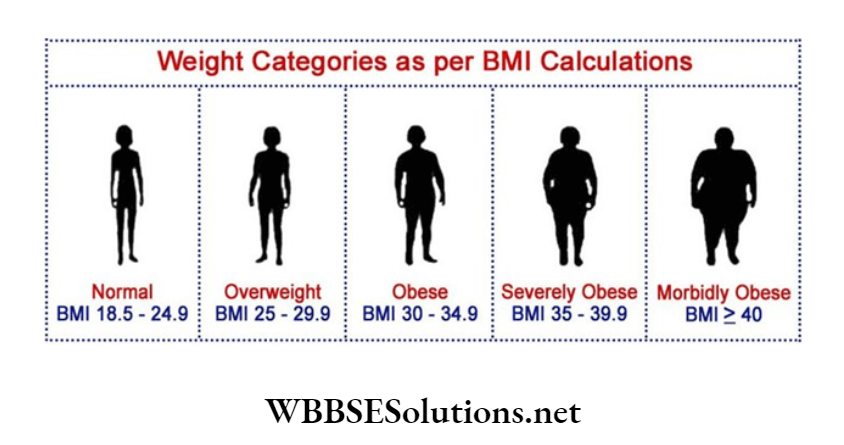
BMI < 15 (Excessively low weight)
BMI 16-18 (Low weight)
BMI 19-24.9 (Desirable)
BMI 25-29.9 (Overweight)
BMI30-34.9 (Obese, category 1)
BMI 35-39.9 (Obese, category 2)
BMI > 40 (Severe obesity)
Heart disease, diabetes, and high blood pressure are all linked to being overweight and obese.
Interesting Facts About Human Body
The human body is made up of a head, a neck, a torso (trunk), two arms, and two legs. The average height of an adult human is about 5 to 6 feet.
The human body is made to stand erect, walk on two feet, use the arms to carry and lift, and have opposable thumbs (able to grasp).
The adult body is made up of 100 trillion cells, 206 bones, 650 muscles, and 22 internal organs.
Every square inch of the human body has about 19 million skin cells.
In every hour about 1 billion cells in the human body must be replaced.
The average human head has about 100,000 hairs.
The average adult takes over 20,000 breaths a day.
The circulatory system of arteries, veins, and capillaries is about 60,000 miles long.
The heart beats more than 2.5 billion times in an average lifetime.
There are about 9,000 taste buds on the surface of the tongue, in the throat, and on the roof of the mouth.
The strongest (powerful) muscle in the body is the tongue.
The human heart creates enough pressure when it pumps out to the body to squirt blood bo 30 feet.
You blink over 10,000,000 times a year.
The human brain weighs about 3 pounds.
The brain uses over a quarter of the oxygen used by the human body.
Your heart beats around 100000 times a day, 36500000 times a year, and over a billion times if you live beyond 30.
Red blood cells carry oxygen around the body. They are created inside the bone marrow of your bones.
The color of human skin is determined by the level of pigment melanin that the body produces. Those with a small amount of melanin have light skin while those with a large amount have dark skin.
Adult lungs have a surface area of around 70 square meters.
Humans have a stage of sleep that features rapid eye movement (REM). REM sleep makes up around 25% of total sleep time and is often when you have your most vivid dreams.
Most adults have 32 teeth.
The smallest bone found in the human body is located in the middle ear. The stapes (or stirrup) bone is only 2.8 millimeters long.
Infants blink only once or twice a minute while adults average around 10.
As well as having unique fingerprints, humans also have unique tongue prints.
The left side of your body is controlled by the right side of your brain while the right side of your body is controlled by the left side of your brain.
Antibiotics are only effective against bacteria; they do not help in fighting off a virus.
It takes about 12 hours to completely digest eaten food.
Your sense of smell is around 10000 times more sensitive than your sense of taste.
It takes about 20 seconds for a red blood cell to circle the whole body.
One-fourth of the bones in your body are in your feet.
The blood processing in the kidneys amounts to some 1.25 liters a minute, or 1800 liters a day (1.25 × 60 × 24 = 1800), which is about 400 times the total blood volume and roughly one-fourth the volume pumped each day by the heart.
Every 24 hours, 170 liters of water is filtered from the bloodstream into the renal tubules; and by far the greater part of this- some 168.5 liters of water together with salts dissolved in it is reabsorbed by the cells lining the tubules and returned to the blood.
In a 24-hour period, an average man eliminates only 1.5 liters of water, containing the waste products of metabolism, but the actual volume varies with fluid intake and occupational and environmental factors.

